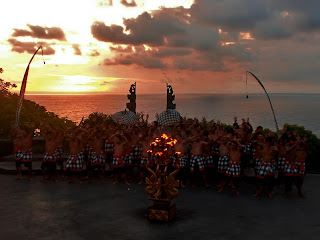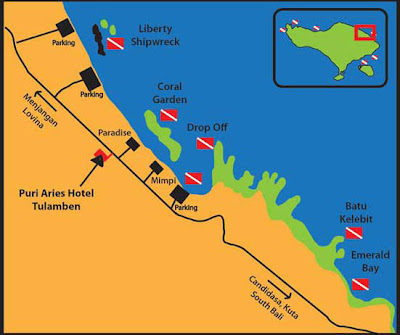Uluwatu temple or Pura Uluwatu is located in the Pecatu Village, Kuta district, Badung.
Uluwatu Temple is located at the southwestern tip of the island of Bali on the bridge of rocks and high cliffs jutting into the sea and is Pura Sad Kayangan believed by Hindus as a buffer from 9 of the compass.
Uluwatu temple was originally used to place worship a holy priest from the 11th century named Empu Kuturan. He lowered teaching traditional village with all the rules. Uluwatu temple is also used to worship the holy priest followed, namely Dang Hyang Nirartha, who came to Bali in late 1550 and ended the trip with a so-called holy Moksah or Ngeluhur in place. That is the word from which the name of Uluwatu. |
| Uluwatu Temple |
Pura Uluwatu or Uluwatu Temple is located at an altitude of 97 meters above sea level. In front of the temple there is a small forest called kekeran base, serves as a buffer sanctity of the temple.
Pura Uluwatu temple has several pesanakan, the temple is closely related to the main temple. Pura pesanakan it is Pura Bajurit, Pura Pererepan, Pura Kulat, Pura Dalem Selonding and Pura Dalem Pangleburan. Each temple has a close relation with the Pura Uluwatu, especially in the days of his piodalan (temple festival). Piodalan at Pura Uluwatu fell on Tuesday Kliwon Wuku Medangsia every 210 days. Manifestation of God who was worshiped in the Pura Uluwatu is the god Rudra.
Pura Uluwatu temple has several pesanakan, the temple is closely related to the main temple. Pura pesanakan it is Pura Bajurit, Pura Pererepan, Pura Kulat, Pura Dalem Selonding and Pura Dalem Pangleburan. Each temple has a close relation with the Pura Uluwatu, especially in the days of his piodalan (temple festival). Piodalan at Pura Uluwatu fell on Tuesday Kliwon Wuku Medangsia every 210 days. Manifestation of God who was worshiped in the Pura Uluwatu is the god Rudra.
 |
| the Monkey at Uluwatu Temple |
Uluwatu temple is also known for directly below is the beach Pecatu often used as a place for surfing sports, even international events are often held here. The surf beach is very suitable to be famous surfing spot in addition to the natural beauty of Bali are indeed very beautiful.
at Uluwatu Temple you can see there are a lot of monkeys, so be careful carrying your stuff, handbags, hats, sunglasses, wallets etc. There you can also see the Kecak performance during sunset, the scenery is very beautiful.
at Uluwatu Temple you can see there are a lot of monkeys, so be careful carrying your stuff, handbags, hats, sunglasses, wallets etc. There you can also see the Kecak performance during sunset, the scenery is very beautiful.
 |
| Kecak Dance during the sunset |
Label:
Bali Interesting Places,
Beach,
South Bali,
Temple


















































